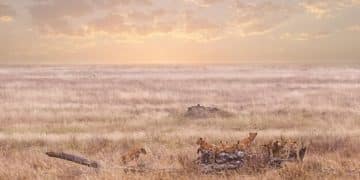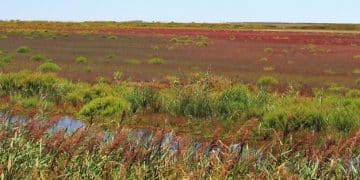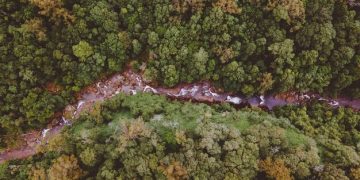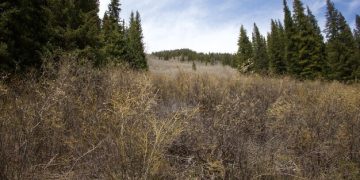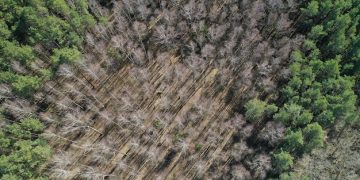Invasive Species Alert: Protecting Wildlife – Your Role
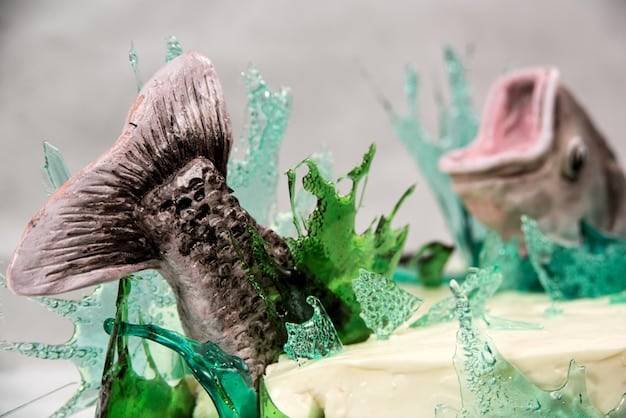
Invasive species pose a significant threat to native wildlife in the US, disrupting ecosystems and causing declines in native populations; understanding their impact and taking action is crucial for conservation efforts.
An urgent alert: invasive species threatening native wildlife – what can you do? is a question that should be on everyone’s mind. The introduction of non-native plants and animals can wreak havoc on ecosystems, pushing native species to the brink and altering the very fabric of our natural landscapes.
Understanding the Invasive Species Crisis
The term “invasive species” might sound like something out of a science fiction movie, but it’s a very real and pressing issue impacting ecosystems across the United States. These unwanted guests, often introduced unintentionally or carelessly, can outcompete native species, alter habitats, and spread diseases, leading to devastating consequences for biodiversity and ecosystem health.
Understanding the gravity of this crisis is the first step in taking action to protect our native wildlife. Recognizing how these species arrive and the damage they inflict paints a clearer picture of what needs to be done.
How Invasive Species Arrive
Invasive species don’t magically materialize. They are often introduced through human activities, either intentionally or accidentally. Common pathways include:
- Global Trade and Travel: Ships can carry invasive species in their ballast water, while airplanes can transport insects or seeds.
- Pet Trade: Released or escaped pets can establish themselves in new environments and become invasive.
- Horticulture: Ornamental plants, brought in for landscaping, can escape cultivation and spread aggressively.
- Construction and Development: Movement of soil and materials during building projects can unintentionally spread invasive plants and insects.
The Damage They Inflict
Once established, invasive species can have a profound impact on native ecosystems. These impacts can include:
- Competition: Invasive species often outcompete native species for resources like food, water, and habitat, leading to declines in native populations.
- Predation: Some invasive species are aggressive predators that can decimate native prey populations, like the brown tree snake in Guam wiping out native bird populations.
- Habitat Alteration: Invasive plants can transform habitats, changing the structure and composition of vegetation, impacting the animals that rely on those habitats.
- Disease Transmission: Invasive species can introduce new diseases or parasites that native species have no immunity to, causing widespread illness and death.
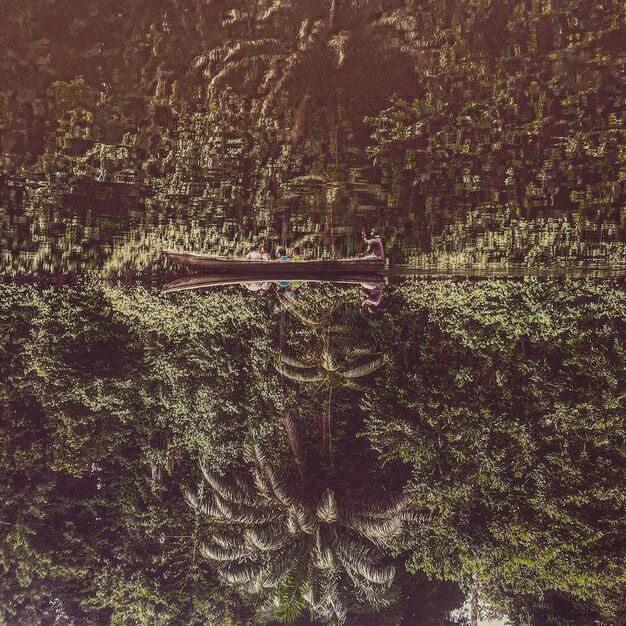
Ultimately, understanding how invasive species arrive and the damage they cause is essential for raising awareness and putting effective prevention and control strategies into place. We all have a part to play in protecting our native wildlife from this pervasive threat.
Identifying Common Invasive Species in Your Area
Now that we grasp the severity of the problem in general, it’s vital to become familiar with the specific invasive species threatening your local environment. Identification is the crucial first step in acting locally and contributing to broader conservation efforts. Different regions of the US face unique invasive challenges, and learning to recognize the most common culprits empowers you to take targeted action.
Knowing these species not only helps you avoid unintentionally spreading them but also enables you to report sightings and participate in removal efforts. This knowledge is your first line of defense.
Plants: Unwanted Greenery
- Garlic Mustard (Alliaria petiolata): A common forest invader, garlic mustard releases chemicals that inhibit the growth of native plants.
- Japanese Knotweed (Reynoutria japonica): This rapidly growing plant forms dense thickets, outcompeting native vegetation and damaging infrastructure.
- Purple Loosestrife (Lythrum salicaria): Found in wetlands, purple loosestrife can form dense monocultures, reducing biodiversity and impacting wetland ecosystems.
Animals: Intruders on the Move
- Zebra Mussels (Dreissena polymorpha): These small mussels clog water pipes, disrupt food webs, and outcompete native mussels.
- Asian Carp (Various species): Voracious eaters, Asian carp can decimate native fish populations and disrupt aquatic ecosystems.
- Emerald Ash Borer (Agrilus planipennis): This beetle has killed millions of ash trees across North America, causing widespread ecological and economic damage.
Resources for Identification
Identifying invasive species isn’t always easy, but many resources can help:
- State and Federal Agencies: Most states have websites with comprehensive information on invasive species in their region, including identification guides and reporting mechanisms.
- University Extension Services: Local extension offices offer workshops, guides, and expert advice on identifying and managing invasive species.
- Citizen Science Apps: Apps like iNaturalist allow you to photograph and identify plants and animals, contributing valuable data to research and conservation efforts.
Becoming familiar with the invasive species in your area doesn’t require expert knowledge, just a willingness to learn and observe. By knowing what to look for, you can become a valuable asset in the fight against invasive species.
Simple Actions, Big Impact: What You Can Do
Feeling overwhelmed by the scale of the invasive species issue is understandable, but the truth is that every action, no matter how small, contributes to the solution. Many simple steps can be taken in our daily lives to prevent the spread of these unwanted species and help protect native wildlife. These actions, when adopted collectively, can create a significant positive impact on the health of our ecosystems.
These small changes in habits and routines can add up, creating a noticeable difference over time. Remember, collective action makes a big impact.
At Home and in Your Yard
Your home and yard can be a starting point for invasive species prevention:
- Choose Native Plants: When landscaping, opt for native plants adapted to your local climate and soil conditions. They provide habitat and food for native wildlife.
- Avoid Using Invasive Ornamentals: Research plants before buying them to ensure they are not invasive in your area.
- Control Invasive Plants on Your Property: Remove invasive plants from your yard and garden, following best practices for disposal to prevent further spread.
When Enjoying the Outdoors
Recreational activities can unintentionally contribute to the spread of invaders. Be mindful of these practices:
- Clean Your Gear: Before and after hiking, camping, or boating, clean your boots, clothing, and gear to remove seeds, mud, or other potential carriers of invasive species.
- Don’t Move Firewood: Firewood can harbor invasive insects and diseases. Buy firewood locally or gather it responsibly.
- Stay on Designated Trails: Avoid venturing off-trail to prevent disturbing habitats and spreading invasive plants or seeds.
Become a Citizen Scientist
Even if you’re not a trained scientist, you can contribute valuable data to research and conservation efforts:
- Report Sightings: Use online reporting tools or smartphone apps to report any sightings of invasive species in your area.
- Participate in Volunteer Efforts: Join local volunteer groups or organizations that conduct invasive species removal projects.
- Educate Others: Share your knowledge about invasive species with friends, family, and neighbors to raise awareness and encourage action.
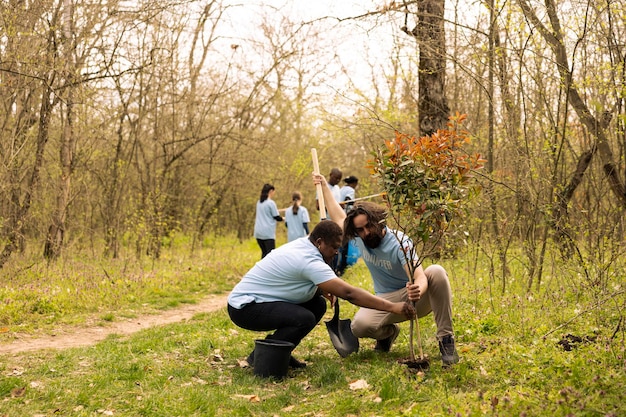
By taking these simple actions, we can all contribute to the fight against invasive species and protect the native wildlife that depends on healthy ecosystems. Every little bit truly helps.
The Importance of Native Plants and Biodiversity
Understanding the threat posed by invasive species also highlights the critical importance of native plants and biodiversity. Native plants have evolved alongside local wildlife, forming intricate relationships that support healthy ecosystems. These ecosystems, in turn, provide essential services like clean air and water, pollination, and climate regulation.
Protecting biodiversity is not just about preserving picturesque landscapes; it’s about ensuring the long-term health and resilience of our planet.
The Role of Native Plants
Native plants are the foundation of healthy ecosystems. They provide:
- Food and Habitat: Native plants offer food and shelter for native insects, birds, mammals, and other wildlife.
- Pollination: Native plants rely on native pollinators like bees, butterflies, and hummingbirds to reproduce, supporting both plant and pollinator populations.
- Erosion Control: Native plants help prevent soil erosion, protecting water quality and stabilizing landscapes.
The Benefits of Biodiversity
Biodiversity, the variety of life on Earth, is essential for ecosystem function and stability. It provides:
- Ecosystem Resilience: Diverse ecosystems are better able to withstand disturbances like climate change, disease outbreaks, and invasive species.
- Essential Services: Biodiversity supports essential services like clean air and water, pollination, and climate regulation, which are vital for human well-being.
- Economic Benefits: Biodiversity provides economic benefits through tourism, recreation, and the provision of natural resources.
Supporting native plant communities and promoting biodiversity are critical strategies for protecting against the harmful effects of invasive species and ensuring the long-term health of our ecosystems.
Supporting Organizations and Initiatives
Fortunately, numerous organizations and initiatives are dedicated to fighting invasive species and promoting wildlife conservation. By supporting these efforts, you can amplify your impact and contribute to a larger movement for environmental protection. These organizations provide valuable resources, conduct research, implement control measures, and educate the public about the importance of biodiversity.
Donating time, money, or simply spreading awareness about these organizations can significantly contribute to their mission.
National Organizations
Several national organizations are leading the charge against invasive species:
- The Nature Conservancy: This global organization works to protect ecologically important lands and waters, including combating invasive species.
- The National Wildlife Federation: NWF advocates for wildlife conservation and provides resources for controlling invasive species.
- The US Fish and Wildlife Service: This federal agency works to protect and manage fish, wildlife, and their habitats, including addressing the threat of invasive species.
Local and Regional Initiatives
Many local and regional initiatives are working to combat invasive species in specific areas:
- State Invasive Species Councils: Many states have councils that coordinate invasive species management efforts and provide resources for residents.
- Local Land Trusts: Land trusts protect ecologically important lands in local communities, often including invasive species control efforts.
- Watershed Organizations: Watershed organizations work to protect and restore water quality, often including invasive species management in their efforts.
By supporting these organizations and initiatives, you can contribute to a collaborative effort to protect our native wildlife and ecosystems from the threat of invasive species. Whether it’s through financial donations, volunteer work, or simply spreading awareness, every contribution makes a difference.
Staying Informed: Long-Term Vigilance
The fight against invasive species is an ongoing effort that requires long-term vigilance and adaptation. New invasive species are constantly being introduced, and control strategies need to evolve to keep pace with their spread. Staying informed about the latest threats and management techniques is crucial for playing an active role in protecting our native wildlife.
Remaining engaged and informed allows you to adapt your actions and contribute effectively to the ongoing battle.
Following News and Research
Stay up-to-date on the latest news, research, and best practices for invasive species management by:
- Subscribing to Newsletters: Sign up for newsletters from conservation organizations, government agencies, and research institutions.
- Following Social Media: Follow relevant accounts on social media to stay informed about emerging threats and control efforts.
- Attending Workshops and Conferences: Participate in workshops and conferences to learn from experts and connect with other concerned citizens.
Adapting Your Actions
As new information becomes available, be prepared to adapt your actions:
- Adjust Control Strategies: Modify your control strategies based on the latest research and best practices.
- Report New Sightings: Be vigilant for new invasive species in your area and report any sightings promptly.
- Educate Others: Share new information and best practices with friends, family, and neighbors.
| Key Point | Brief Description |
|---|---|
| 🌱 Identify Invasives | Learn to recognize common invasive species in your area. |
| 🧹 Clean Gear | Clean gear after outdoor activities to prevent spreading seeds. |
| 🌿 Choose Natives | Plant native species to support local wildlife and biodiversity. |
| 📣 Report Sightings | Report invasive species sightings to help track and manage populations. |
Frequently Asked Questions
▼
Invasive species are non-native plants, animals, or microorganisms that cause harm to the environment, economy, or human health. They often outcompete native species.
▼
They disrupt ecosystems, reduce biodiversity, damage infrastructure, and can spread diseases. This results in significant ecological and economic costs.
▼
Use online resources, field guides, and citizen science apps to identify invasive species in your area. Contact local extension services for expert advice.
▼
Clean gear after outdoor activities, plant native species, report sightings, and participate in removal projects. Educate others about the issue.
▼
Report sightings to your state’s invasive species council, local land trusts, or through citizen science apps. Provide photos and location details.
Conclusion
The urgent alert: invasive species threatening native wildlife – what can you do? is a call to action that we must all heed. By understanding the threat, taking simple preventative measures, and supporting conservation efforts, we can collectively protect our native wildlife and preserve the health of our ecosystems for future generations.
